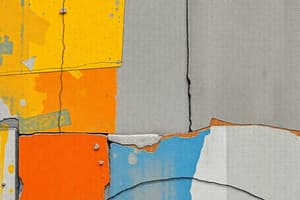Podcast
Questions and Answers
Which material has the highest yield strength ($σ_{YS}$)?
Which material has the highest yield strength ($σ_{YS}$)?
- Stainless steel
- Al alloy 2
- Ti alloy (correct)
- Al alloy 1
What is the primary factor that maximizes stiffness in bending according to the equations provided?
What is the primary factor that maximizes stiffness in bending according to the equations provided?
- Material Cost
- Yield Strength ($σ_{YS}$)
- Elastic Modulus ($E$) (correct)
- Density ($ρ$)
Which material has the lowest cost per tonne?
Which material has the lowest cost per tonne?
- Al alloy 2
- Stainless steel
- Al alloy 1 (correct)
- Ti alloy
Which material exhibits the highest crack resistance based on the $K_{IC}$ value?
Which material exhibits the highest crack resistance based on the $K_{IC}$ value?
In which scenario is the strength (buckling/tension) maximized?
In which scenario is the strength (buckling/tension) maximized?
What characterizes the propagation stage of failure in materials?
What characterizes the propagation stage of failure in materials?
Which of the following best describes a consequence of poor designing in mechanical components?
Which of the following best describes a consequence of poor designing in mechanical components?
What should be considered regarding material selection?
What should be considered regarding material selection?
Which type of material defect can initiate crack propagation leading to failure?
Which type of material defect can initiate crack propagation leading to failure?
What is the primary effect of sintering on ceramic bodies?
What is the primary effect of sintering on ceramic bodies?
What role do stress raisers play in material failure?
What role do stress raisers play in material failure?
Which material is commonly used for high hardness and low friction applications?
Which material is commonly used for high hardness and low friction applications?
In failure analysis, why is a systematic approach crucial?
In failure analysis, why is a systematic approach crucial?
Which characteristic is crucial for cutting tools made from ceramics?
Which characteristic is crucial for cutting tools made from ceramics?
What is one of the requirements for materials used in heat engines?
What is one of the requirements for materials used in heat engines?
How can the environment affect material performance?
How can the environment affect material performance?
Which of the following materials is used in medical implants for its biocompatibility?
Which of the following materials is used in medical implants for its biocompatibility?
Which of the following can serve as sources of metal part failures?
Which of the following can serve as sources of metal part failures?
What is a significant benefit of using ceramics in the design of engines and turbines?
What is a significant benefit of using ceramics in the design of engines and turbines?
Which application of ceramics requires improved durability and lower overall cost?
Which application of ceramics requires improved durability and lower overall cost?
Which property is not typically required for wear parts made from ceramics?
Which property is not typically required for wear parts made from ceramics?
What is a necessary condition for brittle fracture to occur?
What is a necessary condition for brittle fracture to occur?
Which of the following factors can lower the transition temperature in steels?
Which of the following factors can lower the transition temperature in steels?
Which characteristic generally differentiates brittle fractures from ductile fractures?
Which characteristic generally differentiates brittle fractures from ductile fractures?
What can be done to mitigate the risk of brittle fracture?
What can be done to mitigate the risk of brittle fracture?
What is one method to potentially increase resistance to fatigue failure in metals?
What is one method to potentially increase resistance to fatigue failure in metals?
What type of fracture path is typically associated with brittle fractures?
What type of fracture path is typically associated with brittle fractures?
Why are notches and cracks problematic in materials that may fail by brittle fracture?
Why are notches and cracks problematic in materials that may fail by brittle fracture?
How can tensile strength in a metal be increased?
How can tensile strength in a metal be increased?
What is a characteristic feature of brittle fractures when viewed microscopically?
What is a characteristic feature of brittle fractures when viewed microscopically?
What surface condition technique can help improve fatigue resistance?
What surface condition technique can help improve fatigue resistance?
Which option best describes the main challenge of brittle crack propagation compared to initiation?
Which option best describes the main challenge of brittle crack propagation compared to initiation?
Which method is NOT effective for hardening the surface of materials?
Which method is NOT effective for hardening the surface of materials?
What effect does alloying have on unstable alloys regarding fatigue strength?
What effect does alloying have on unstable alloys regarding fatigue strength?
What primarily accounts for the hardness of ceramics?
What primarily accounts for the hardness of ceramics?
What is the main reason for the brittleness observed in ceramics?
What is the main reason for the brittleness observed in ceramics?
Which of the following is a method of case hardening for steel components?
Which of the following is a method of case hardening for steel components?
What is a purpose of modifying a mould design in manufacturing processes?
What is a purpose of modifying a mould design in manufacturing processes?
Which step is NOT involved in the processing of ceramic components?
Which step is NOT involved in the processing of ceramic components?
What role does a better surface finish play in machinery operations?
What role does a better surface finish play in machinery operations?
How does the presence of defects in ceramic materials affect their strength?
How does the presence of defects in ceramic materials affect their strength?
What method is typically used for powder production in advanced engineering ceramics?
What method is typically used for powder production in advanced engineering ceramics?
What is the main purpose of firing or sintering in ceramic processing?
What is the main purpose of firing or sintering in ceramic processing?
Which of the following correctly describes the packing of ceramic materials?
Which of the following correctly describes the packing of ceramic materials?
What role do electrostatic forces play in the behavior of ceramic materials?
What role do electrostatic forces play in the behavior of ceramic materials?
Flashcards
Why are ceramics hard?
Why are ceramics hard?
The bonds in ceramics make them resistant to movement, leading to high hardness.
What makes a ceramic brittle?
What makes a ceramic brittle?
These are flaws in the material that make it easier to break. They make the material brittle.
What's Powder Production in ceramics?
What's Powder Production in ceramics?
The first step in ceramic processing involves making the powdered material needed to form the final component.
What is Compacting or Pressing?
What is Compacting or Pressing?
Signup and view all the flashcards
What is Firing or Sintering?
What is Firing or Sintering?
Signup and view all the flashcards
Stiffness (Bending)
Stiffness (Bending)
Signup and view all the flashcards
Strength (Tension/Buckling)
Strength (Tension/Buckling)
Signup and view all the flashcards
Crack Resistance
Crack Resistance
Signup and view all the flashcards
Elastic Modulus (E)
Elastic Modulus (E)
Signup and view all the flashcards
Yield Strength (σYS)
Yield Strength (σYS)
Signup and view all the flashcards
Brittle Fracture
Brittle Fracture
Signup and view all the flashcards
Transition Temperature
Transition Temperature
Signup and view all the flashcards
Stress Concentration
Stress Concentration
Signup and view all the flashcards
Fracture Toughness
Fracture Toughness
Signup and view all the flashcards
Transgranular Fracture
Transgranular Fracture
Signup and view all the flashcards
Intergranular Fracture
Intergranular Fracture
Signup and view all the flashcards
Chevron Markings
Chevron Markings
Signup and view all the flashcards
Absence of Plastic Deformation
Absence of Plastic Deformation
Signup and view all the flashcards
Material Defect
Material Defect
Signup and view all the flashcards
Crack Propagation
Crack Propagation
Signup and view all the flashcards
Catastrophic Failure
Catastrophic Failure
Signup and view all the flashcards
Stress Raisers
Stress Raisers
Signup and view all the flashcards
Material Selection
Material Selection
Signup and view all the flashcards
Cyclic Loading
Cyclic Loading
Signup and view all the flashcards
Gas Porosity
Gas Porosity
Signup and view all the flashcards
Failure Investigation
Failure Investigation
Signup and view all the flashcards
Sintering
Sintering
Signup and view all the flashcards
Powder Pressing
Powder Pressing
Signup and view all the flashcards
Slip Casting
Slip Casting
Signup and view all the flashcards
Wear Parts (Ceramics)
Wear Parts (Ceramics)
Signup and view all the flashcards
Cutting Tools (Ceramics)
Cutting Tools (Ceramics)
Signup and view all the flashcards
Heat Engines (Ceramics)
Heat Engines (Ceramics)
Signup and view all the flashcards
Medical Implants (Ceramics)
Medical Implants (Ceramics)
Signup and view all the flashcards
Construction (Ceramics)
Construction (Ceramics)
Signup and view all the flashcards
Changing Manufacturing Processes to Increase Resistance to Fatigue
Changing Manufacturing Processes to Increase Resistance to Fatigue
Signup and view all the flashcards
Improving Existing Manufacturing Processes
Improving Existing Manufacturing Processes
Signup and view all the flashcards
Relationship between Fatigue Strength and Tensile Strength
Relationship between Fatigue Strength and Tensile Strength
Signup and view all the flashcards
Effect of Alloying on Fatigue Strength
Effect of Alloying on Fatigue Strength
Signup and view all the flashcards
How Surface Hardening Improves Fatigue Resistance
How Surface Hardening Improves Fatigue Resistance
Signup and view all the flashcards
Methods of Surface Hardening
Methods of Surface Hardening
Signup and view all the flashcards
Shot Peening
Shot Peening
Signup and view all the flashcards
Cold Rolling
Cold Rolling
Signup and view all the flashcards
Study Notes
Module Overview
- Course Title: Engineering Materials II
- Course Code: ME2301
- Institution: Singapore Polytechnic, School of Mechanical and Aeronautical Engineering
Module Aims
- Aims to provide a foundation of principles governing engineering material properties and their behavior during processing and service.
- Aims to equip students with knowledge of metallurgical processes used in industry and methods for assessing materials defects.
Module Contents
- Materials Selection Methodology: 2 hours
- Failure of Metals: 6 hours
- Ceramics and Composites: 5 hours
- Non-Destructive Testing: 6 hours
- Corrosion: 5 hours
- Heat Treatment of Carbon and Alloy Steels: 6 hours
Teaching Plan
- Provides a schedule for lectures, tutorials, and laboratories.
- Outlines the topics covered in each week.
- Includes details of lab/tutorial assignments.
- Notes that the schedule is subject to change.
Assessment
- Mid-Semester Test (MST): 20% (20 Multiple Choice, 2 Structured Questions)
- Semester Examination (EXAM): 40% (20 Multiple Choice, 5 Structured Questions)
- Laboratory Reports (LAB): 20% (5 reports, each 4%)
- Tutorials (CA): 10% (Assessed on punctuality, attitude, participation, prep effort and a report on “Materials Selection”
- Case Study (CA): 10%
Resource Material
- No single book covers all module topics.
- Students will be provided with lecture handouts, tutorials, and laboratory materials.
References
- Provides a list of available reference books in the library.
- Includes titles and authors for each book relevant to the course.
Studying That Suits You
Use AI to generate personalized quizzes and flashcards to suit your learning preferences.




